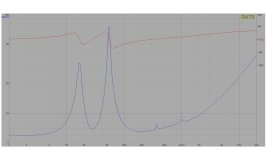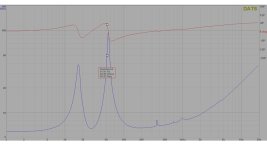Attached is my impedance sweep of a Satori 9.5" WO24P 8 ohm woofer. This sweep was taken using Dats 3 with the woofer installed in its enclosure. As you can see, there are 3 distinct blips to the right of the woofer resonance curves that catch your attention. The blip farthest to the right at 1Khz also shows up in the free air sweep (not attached) so has nothing to do with my enclosure. I have no idea what this blip is from, but since it's well past my target crossover point of 500hz, I'm ignoring it. I'm not sure what the middle blip at ~700Hz is from, but I'm guessing it's my 6" long x 2" diameter vent tube. The 3rd blip at ~364Hz would appear to be a standing wave from my woofer enclosure. The enclosure is a roughly 1.4 cu ft cylinder with a 13.2 inch inner diameter.
I have no real idea if the amplitude of any of these blips warrant attention, but I decided to try to cut down the one at 364Hz as it's within my target crossover frequency. My first attempt was to install rockwool to see how well it reduces the standing wave. The rockwool I have is very fragile and didn't conform well to my enclosure. I covered the bottom and about half way up both sides of the enclosure and took another sweep. The amplitude of the blip at 364hz was reduced by about half, so I believe it is my enclosure causing it. I attempted to install the rockwool to the enclosure top, but only caused it to break into multiple pieces. At this point, I did more research and decided to remove the rockwool and try Acoust-X paint by Acry-Tech.
The first thing to know about this paint is how to open it. It has instructions on the lid, but they're not clear at all. What they want you to do is push down in the center of the lid while simultaneously prying up on the outer lid rim with a screwdriver. This works, but takes a lot of force to open. It can also be messy so wear gloves even when just opening the container. You should also wear gloves and ensure good ventilation when applying as the MSDS for this stuff has several health warnings (Including potentially being a carcinogen).
Next I used a small paintbrush to apply to all the inner enclosure surfaces. This paint is thick - much like a good thick milkshake. It does not go on well by using brush strokes. You're better off dabbing it on as brushing seems to just push it around rather than coating the surfaces. I put on 1 coat and left to dry. The container gives no directions relative to drying time, so I returned to inspect the coating after 30 minutes, 1 hour, 5 hours, and 24 hours only to find that the coating was still wet. I let it dry another 24 hours (Still wet), but applied the second coat anyway. In fairness, I was applying the coating in my cool basement, so that could be part of the reason it wasn't curing well. After applying the 2nd coat, I placed a small fan blowing into the enclosure. The fan was the trick as the 2nd coating was dry after 24 hours. I ended up putting on a 3rd coating to cover a few spots I missed and once again used the fan to dry (Waiting another 24 hours).
The instructions say to clean up with water, which works well. The brush is easy to clean and can be reused several times as a result of the easy water cleanup.
The 2nd attached file shows the Dats 3 impedance sweep of the woofer after applying the paint. It appears to have narrowed the frequency a bit, but also increased the amplitude. Again, I don't know how big of a problem this is, but it appears the sound damping properties of the Acoust-x paint did not improve (and may have made worse) the standing wave (If in fact this is a standing wave) problem.
I'd be interested to hear others thoughts on this and if you've tried this paint
I have no real idea if the amplitude of any of these blips warrant attention, but I decided to try to cut down the one at 364Hz as it's within my target crossover frequency. My first attempt was to install rockwool to see how well it reduces the standing wave. The rockwool I have is very fragile and didn't conform well to my enclosure. I covered the bottom and about half way up both sides of the enclosure and took another sweep. The amplitude of the blip at 364hz was reduced by about half, so I believe it is my enclosure causing it. I attempted to install the rockwool to the enclosure top, but only caused it to break into multiple pieces. At this point, I did more research and decided to remove the rockwool and try Acoust-X paint by Acry-Tech.
The first thing to know about this paint is how to open it. It has instructions on the lid, but they're not clear at all. What they want you to do is push down in the center of the lid while simultaneously prying up on the outer lid rim with a screwdriver. This works, but takes a lot of force to open. It can also be messy so wear gloves even when just opening the container. You should also wear gloves and ensure good ventilation when applying as the MSDS for this stuff has several health warnings (Including potentially being a carcinogen).
Next I used a small paintbrush to apply to all the inner enclosure surfaces. This paint is thick - much like a good thick milkshake. It does not go on well by using brush strokes. You're better off dabbing it on as brushing seems to just push it around rather than coating the surfaces. I put on 1 coat and left to dry. The container gives no directions relative to drying time, so I returned to inspect the coating after 30 minutes, 1 hour, 5 hours, and 24 hours only to find that the coating was still wet. I let it dry another 24 hours (Still wet), but applied the second coat anyway. In fairness, I was applying the coating in my cool basement, so that could be part of the reason it wasn't curing well. After applying the 2nd coat, I placed a small fan blowing into the enclosure. The fan was the trick as the 2nd coating was dry after 24 hours. I ended up putting on a 3rd coating to cover a few spots I missed and once again used the fan to dry (Waiting another 24 hours).
The instructions say to clean up with water, which works well. The brush is easy to clean and can be reused several times as a result of the easy water cleanup.
The 2nd attached file shows the Dats 3 impedance sweep of the woofer after applying the paint. It appears to have narrowed the frequency a bit, but also increased the amplitude. Again, I don't know how big of a problem this is, but it appears the sound damping properties of the Acoust-x paint did not improve (and may have made worse) the standing wave (If in fact this is a standing wave) problem.
I'd be interested to hear others thoughts on this and if you've tried this paint

